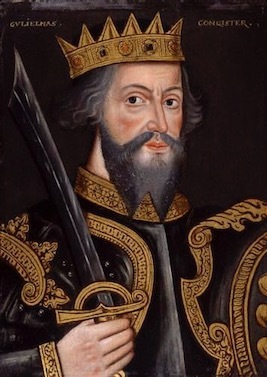On William the Conqueror
17/08/15 22:12 Filed in: History
In this blog post I take a brief look at the life of William the Conqueror, a man who started life as the bastard son of a Norman duke and rose up to become the Duke of Normandy and later William I, King of England.
A man who is also my 31st great grandfather.
A man who is also my 31st great grandfather.

Unfortunately, no known authentic portrait exists of William, however, written descriptions have him as burly and robust with a guttural voice. From an examination of what is left of his skeleton we now know he would have been 5 feet 10 inches tall. He was said to be very fit and strong but became quite fat in later life.
In 1051/2 he married the woman who would go on to bear him nine children including two future kings, Matilda of Flanders. However before their marriage or even engagement their relationship would get off to a rocky start when William sent his representatives to propose to her, she turned him down flatly, stating that she was far too high-brow to marry a bastard. In a rage of anger at being disrespected in this manner, he rode from Normandy to her, finding her riding to church he is said to have grabbed her by her braided hair and thrown her from her horse to the ground.
After a start such as this we may never know if she grew to love him, however, William was smitten with her and after she died at the age of 51, he became very depressed.
He became a viable claimant to the English throne in the 1050s/60s when he was promised he could have it, by the childless Edward the Confessor, after he died. However, this transaction did not go smoothly for William as Edward is claimed to have changed his mind on his deathbed in January 1066, leaving it instead to Harold Godwinson. William now having become a powerful and rich duke created a large fleet and invaded England in September 1066. William defeated Harold at the now infamous Battle of Hastings on 14th October that same year and was finally crowned King of England on Christmas Day in London. Arguably this made him the first King of England, as his predecessors, such as Alfred the Great were known as the King(s) of the Anglo-Saxons (e.g. King(s) of the English). After a few minor rebellions, his rule in England was mostly secure and he returned to the continent for most of the rest of his reign.
In 1086, William ordered the creation of the historically significant Domesday Book, a survey of the landowners in England and Wales and their belongings, for the purposes of taxation. William commissioned the beginnings of what is now the Tower of London and chose the site for Windsor Castle.
While on a campaign in France on 9th September 1087 he died from internal injuries after falling from his horse and was buried in Caen, France. His eldest son Robert was given Normandy upon the death of his father and his second son William received England, making him William II of England and every English monarch since has directly descended from him.
During the French Revolution, William the Conqueror’s tomb was desecrated, his bones scattered and lost to time.
He who was earlier a powerful king, and lord of many a land, he had nothing of any land but a seven-foot measure; and he who was at times clothed with gold and with jewels, he lay then covered over with earth.
- The Anglo-Saxon Chronicle's Epitaph
William the Conqueror Wikipedia Page: Link
blog comments powered by Disqus

